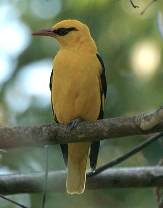
Eurasian Golden Oriole
European and West Asian bird
TERMS (courtesy of Oliver Lu)
Eurasian - A person of mixed European and Asian descent.
Usage Note: Eurasian has been in use since the mid-19th century to refer to a person of mixed European and Asian birth. It was coined during the British rule over India and was long used primarily in designating a person born to a British father and an Indian mother. In a contemporary context Eurasian has a much wider application, denoting only that one parent is Asian and the other whitethat is, either European or of European descent. The geographic sense of Eurasian is quite distinct, referring to the extended landmass of Europe and Asia and especially to the large indeterminate region where the two continents join. Peoples indigenous to this region can also be termed Eurasian, creating a potential ambiguity when referring to an individual as opposed to a group or culture. If the ambiguity is not resolved by context, it may be necessary to use a phrase such as a member of a Eurasian people or a person of European and Asian parentage for clarity. Hapa -Derived from the English word "half", Native Hawaiians used this word to describe someone who was "half Hawaiian". In colonial times, it was often combined with the word "haole" which meant stranger, foreigner, or white person. As time passed, "hapa" was used on the Continental United States by Japanese Americans and other Asian to describe a person of partial Asian ancestry. Many Nisei (second generation Japanese Americans) considered the term to be derogatory. Today, "Hapa" is simply accepted as a way to describe a person of partial Asian ancestry.
Amerasian ("American" + "Asian", usually connotes the children of U.S. servicemen and Asian women)
hapa haole, or just hapa (originally Hawaiian for "part-foreigner/non-Hawaiian [Caucasian]", then part (Hawaiian) Japanese/non-(Hawaiian) Japanese [Caucasian] and finally simply part-Asian/part non-Asian)
haafu (Japanese term from their pronunciation of the English word "half")
konketsuji ([derogatory] Japanese for Amerasians)
ai no ko ([derogatory] Japanese term literally "child of unlike things put together")
bui doi (Vietnamese term for the children of American servicemen and Vietnamese women, means "dust of the earth")
con lai (Vietnamese for "half-breed")
gweilo (Cantonese expression for "white devil", sometimes also used for people of mixed Chinese-American background)
my lai (Vietnamese for "American mix")
luk krueng (Thai phrase meaning "half-children"!)
hun xue (Mandarin Chinese for "mixed blood")
honhyol (Korean for "mixed-race child")
multo ("ghost" in Tagalog [Filipino])
serani (Malay for Eurasian)
indo (Portuguese/Dutch/English-Indonesian)
Some people have also coined neologisms, or new words, for themselves:
Asiapean (Asian-European)
Australasian (Australian-Asian)
Austral-Eurasian (Australian-Eurasian)
Blackanese (Black-Japanese)
Blasian (Black-Asian)
CanAsian (Canadian-Asian)
Eurasiacan (Eurasian-American)
Germericanese (German-American-Chinese)
Koruvian (Korean-Peruvian)
Tight (Thai-White)
Anglo-Burmese
domiciled European
Euro-Asian
Anglo-Asian
Asiatick [sic] Briton
Burghers
domiciled Indian
Eurindian
Euro-Indian
Indo-Briton
Chino-Blanco
|

Model Ankita
Anglo-Indian
Miss India 2001
Celina Jaitly
Anglo-Indian

Model Laurie
Malay/Indian/White

Singer Olivia
Japanese/White

Model/Actress
Rebecca
Chinese/Singaporean/Irish

Miss India World/Model
Sara Corner
Anglo-Indian

MTVAsia VJ Sarah Meier
Filipina/Caucasion

Singer Sean Paul
Jamaican/Euro/Chinese
|